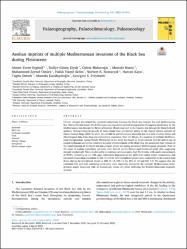| dc.contributor.author | Erginal, Ahmet Evren | |
| dc.contributor.author | Kıyak, Nafiye Güneç | |
| dc.contributor.author | Makaroğlu, Özlem | |
| dc.contributor.author | Bozcu, Mustafa | |
| dc.contributor.author | Öztürk, Muhammed Zeynel | |
| dc.contributor.author | Selim, Hamit Haluk | |
| dc.contributor.author | Nowacyzk, Norbert R. | |
| dc.contributor.author | Kaya, Nurcan | |
| dc.contributor.author | Öztürk, Tuğba | |
| dc.contributor.author | Karabıyıkoğlu, Mustafa | |
| dc.contributor.author | Polymeris, Georgios S. | |
| dc.date.accessioned | 2023-10-21T07:37:15Z | |
| dc.date.available | 2023-10-21T07:37:15Z | |
| dc.date.issued | 2022 | en_US |
| dc.identifier.issn | 0031-0182 | |
| dc.identifier.issn | 1872-616X | |
| dc.identifier.uri | https://hdl.handle.net/11363/5998 | |
| dc.description.abstract | Climate changes determined the repeated connections between the Black Sea, Caspian Sea and Mediterranean
Sea. The landlocked anoxic Black Sea basin was exposed to several transgressions throughout Quaternary by the
Mediterranean Sea through the Straits of Istanbul (Bosphorus) and by the Caspian Sea through the Manych-Kerch
spillway. Sedimentological records of these connections are limited mostly to the marine terrace deposits of
Marine Isotope Stage (MIS) 5e while the pre-MIS 5e period remains uncertain due to a lack of robust facies and
chronological data from deep-sea sedimentary sequences. Here we discuss the imprints of multiple Mediterranean transgressions during Middle Pleistocene in the Black Sea based on facies analysis and the optical age of
coastal carbonate aeolianites. Contrary to today’s hydro-climate of the Black Sea, the aeolianites bear witness to
the transformation of the Black Sea into a warm inland sea during successive Mediterranean invasions. Prior to
the onset of aeolian deposition, paleosols were formed on the Eocene-aged hardened sandy silts, suggesting
strongly washed soil. This is evidenced by no calcium carbonate and a high Rb/Sr ratio, with quartz amounting to
of 99.8%. According to our OSL ages, carbonates deposited on the shelf plain under higher temperature and
increased evaporation conditions in MIS 15 and the later interglacial phases were transported to the coastal sand
dunes during the transitional phases of MIS 15–14, MIS 13–12, MIS 11–10 and MIS 9–8. We suggest that the
carbonate-rich and ooid-containing aeolianites were repeatedly formed in the multiple Mediterranean transgression stages, beginning with an increasingly severe dry phase following the Brunhes-Matuyama magnetic
reversal. | en_US |
| dc.language.iso | eng | en_US |
| dc.publisher | ELSEVIER, RADARWEG 29, 1043 NX AMSTERDAM, NETHERLANDS | en_US |
| dc.relation.isversionof | 10.1016/j.palaeo.2022.110902 | en_US |
| dc.rights | info:eu-repo/semantics/openAccess | en_US |
| dc.rights | Attribution-NonCommercial-NoDerivs 3.0 United States | * |
| dc.rights.uri | http://creativecommons.org/licenses/by-nc-nd/3.0/us/ | * |
| dc.subject | Black Sea | en_US |
| dc.subject | Carbonate aeolianite | en_US |
| dc.subject | Ooid | en_US |
| dc.subject | Paleosol | en_US |
| dc.subject | Climate change | en_US |
| dc.subject | Interglacial | en_US |
| dc.subject | Marine isotope stages | en_US |
| dc.title | Aeolian imprints of multiple Mediterranean invasions of the Black Sea during Pleistocene | en_US |
| dc.type | article | en_US |
| dc.relation.ispartof | Palaeogeography, Palaeoclimatology, Palaeoecology | en_US |
| dc.department | Mühendislik ve Mimarlık Fakültesi | en_US |
| dc.authorid | https://orcid.org/0000-0002-9834-7680 | en_US |
| dc.authorid | https://orcid.org/0000-0001-8598-8596 | en_US |
| dc.identifier.volume | 592 | en_US |
| dc.identifier.startpage | 1 | en_US |
| dc.identifier.endpage | 14 | en_US |
| dc.relation.tubitak | 113Y418 | |
| dc.relation.publicationcategory | Makale - Uluslararası Hakemli Dergi - Kurum Öğretim Elemanı | en_US |
| dc.contributor.institutionauthor | Selim, Hamit Haluk | |



















